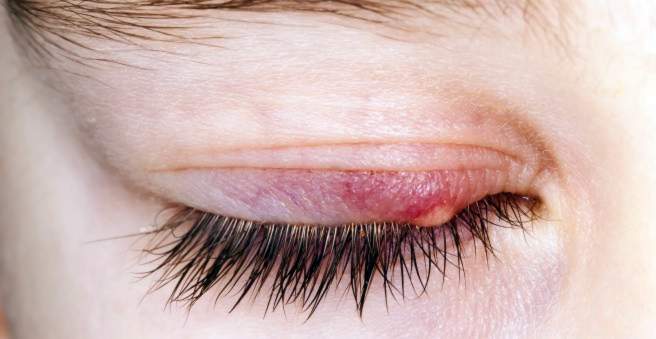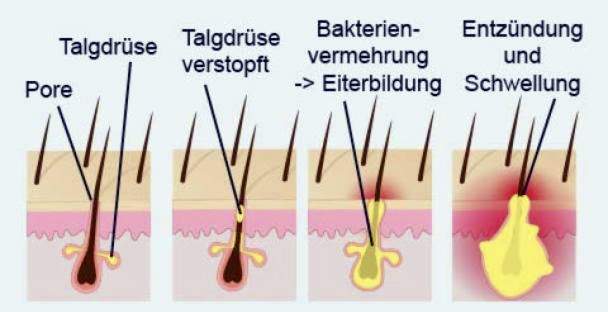An abscess is an encapsulated pus-filled cavity in the tissue. It can form when the body fights a spatially limited infection. An abscess should be recognized and treated as quickly as possible so that the infection does not spread further. Read here how an abscess develops, which discomfort it causes and how it is treated.

Abscess: short overview
- Description: encapsulated pus accumulation in the tissue
- Causes: mostly bacteria, which enter the body via wounds, operations, injections or other means of infection
- Treatment: Opening of the abscess by the doctor, antibiotics
- Forecast: with rapid treatment good chances of recovery, in case of non-treatment threatening blood poisoning
Abscess: description
An abscess is an encapsulated pus buildup in the tissue. Triggers are usually bacteria that invade the tissue. Then the immune system becomes active. So that the infection does not spread further, immune cells melt the affected tissue and encapsulate it by means of a membrane from the surrounding healthy tissue. Inside the cavity, pus accumulates. It is composed of dead tissue, dead immune cells and bacterial remains.
The encapsulation makes it difficult to spread the infection. At the same time get fresh cells of the immune system but only hard to inflammation. Therefore, an abscess must be opened and emptied by the doctor. Otherwise there is a threat of blood poisoning in the worst case.
Abscess: causes
An abscess is usually caused by bacteria that invade the body. Other pathogens are parasites or amoebae.
External injuries
Often a purulent bump is the result of an external injury. In healthy people, the skin forms a natural protection against pathogens. In deeper injuries such as cuts or animal bites, however, bacteria can invade the body and cause an abscess. This risk is greater, the stronger the wound is.
operations
Operations can also give pathogens access to the body. If a particularly high risk of infection exists, the surgeon often creates a drainage. Through them, all liquids can drain away immediately. This prevents pus from accumulating. Risk patients also receive an antibiotic to stifle potential sources of infection in the bud.
Other tissue damages
Particularly susceptible to infections is tissue that has already been damaged elsewhere. Examples are body parts that are poorly supplied with blood due to diabetes or blood clots, or proliferating tissue such as cancer.
Weakened immune system
Prone to an abscess also makes a weakened immune system. Such an immunodeficiency can be the result of an HIV infection, but also of any other infection. Chemotherapy for cancer also weakens the immune system.
Common places of abscesses
An abscess can form anywhere in the body. Certain areas are particularly affected by pus tubercles. Because some parts of the body can easily be attacked by bacteria or other pathogens. Other abscesses develop because of injuries or during an operation, an artificial portal of entry for germs.
Abscess in the abdominal area
Abscesses in the abdomen often arise due to injury or surgery to the intestine. In the intestine countless bacteria live, which play an important role in the digestion (intestinal flora). In a healthy gut, the wall is impervious to pathogens.
However, in diseases such as an appendectomy or bowel injury, bacteria can invade the abdomen. This often inflames the peritoneum. But it can also form abscesses.
Especially under the diaphragm (subphrenic abscess), under the liver (subhepatic abscess), directly on the intestinal loops or between the rectum and bladder / vagina (Douglas abscess) may develop a collection of pus.
Abscesses of internal organs
Abscesses in organs such as the liver are also caused by pathogens that could reach deep into the body via the bloodstream. Highly perfused organs such as the liver and spleen are therefore particularly often affected. For example, parasites such as the fox or dog tapeworm and amoebae prefer abscesses in the liver, since this organ is easily accessible via the blood from the intestine.
Abscess on the anus
Due to the contact with the stool, which is strongly infiltrated with bacteria, abscesses (perianal abscess or periproctic abscess) are particularly common in the anus. On top of that, besides hair and sebaceous follicles, anal glands also sit directly in the anal canal and secrete secretion – good conditions for bacterial infections.
An abscess on the butt may also be an early sign of an inflammatory bowel disease such as Crohn’s disease. Men between the ages of 30 and 50 often develop an abscess on the anus.
Abscess on the face
An abscess on the face often forms in severe acne. When bacteria invade sebaceous glands and thickened sebum moves the exit of the sebaceous gland, a pimple is created. If the bacteria penetrate deeper into the tissue, various inflammatory foci can merge and form a pus in the facial skin.

Abscesses in the mouth
The oral cavity is also heavily populated with bacteria. Dental and mucosal damage can penetrate deep into the tissue, causing inflammation. As the inflammatory response decapsulates, a painful abscess in the mucosa forms. Depending on how deep the pus in the tissue is, one speaks of mucous or submucous abscesses.
Abscess on the tailbone
An abscess on the coccyx often arises in the context of a coccyx fistula (sinus pilonidalis, pilonid cyst): If a hair grows into the skin of the pelvic fold, a channel forms to the skin surface (fistula). Through this gate, bacteria can invade the tissue and cause inflammation with subsequent abscess formation. Obese middle-aged men are particularly often affected.
Abscess on a hair root (boil)
An abscess in the area of a hair root is called a boil. These abscesses thus occur on hairy parts of the body, armpit, scalp and genital area. It forms a painful, tight knot. If several hair follicles are affected, this is called carbuncle.
Abscess of the breast
Women may also develop an abscess in their breasts. For example, when breastfeeding or piercing the nipple bacteria get into the gland ducts. Then the mammary gland can become inflamed. By encapsulation it develops a pus in the breast.
Abscesses by spraying
If a syringe is not sufficiently disinfected, the needle can penetrate bacteria into deeper tissue layers (abscess). For example, a so-called gluteal abscess arises through a needlestick into the pomace (gluteus).
Abscess: symptoms
The symptoms of an abscess can be very diverse. Since an abscess is accompanied by inflammation, there are general signs of inflammation:
- reddening
- swelling
- overheat
- Pain
- Function restriction of the affected area
The type of pus, its smell and its color vary depending on which bacterium has caused the infection.
In abdominal abscess, pain and fever are often the only symptoms. The inflammation can also bring the intestinal function to a halt (constipation or even intestinal obstruction). If the digestion stops, the patient vomits and the bowel movement stops. Since in particular the large intestine is colonized by bacteria, there can be further sources of infection in the abdomen.
Abscess: examinations and diagnosis
If the doctor suspects an abscess, he first of all looks for the typical signs of inflammation. You may also notice the malfunction of the affected body part or organ. For example, nerve inflammations may be present in inflammations in the brain. This can be felt by tingling, pain or paralysis.
blood tests
In liver abscesses the liver function is disturbed. This shows in deteriorated liver enzymes.
Other blood levels may indicate an inflammatory process. Increased levels of white blood cells and the C-reactive protein (CRP for short) usually indicate inflammation in the body.
Imaging procedures
With an ultrasound machine or computed tomography (CT), the doctor can also detect a purulent bulge inside the body. It appears as a roundish structure in otherwise inconspicuous tissue. The wall of the purulent bump appears to be lighter in the ultrasound than the pus inside.
Abscess: treatment
Normally, the immune system dumps dead body cells and pathogens. A purulent bump is difficult for the immune cells to achieve. In order for it to heal, it should be opened and emptied as quickly as possible from the outside.
Abscess surgery
As part of an abscess surgery, the doctor opens an abscess as gently as possible and removes the entire contents in the best case. Depending on the extent and severity of the abscess, the procedure is performed by the family doctor or a surgeon.
Sometimes abscess surgery does not completely remove the pus. Then a drainage is inserted. It serves as a drain for newly developing pus.
For some abscesses, it is sufficient to pierce them. This applies, for example, to very superficial abscesses of the skin. For larger or deeper abscesses, however, the doctor must ensure that the pus cavity is completely emptied and the abscess cavity does not close again, so that the abscess can heal.
Abscess treatment with antibiotics
Antibiotics help combat the bacterial infection. The choice of the remedy depends among other things on the pathogen. An indication of the type of germ supply the location of the abscess as well as the color and smell of the pus. Based on these factors, the doctor can estimate the possible pathogen relatively well.
A bacterium can be clearly identified by analyzing the abscess sample material that the physician gains during abscess surgery. This analysis takes several days.
Commonly used antibiotics in the abscess treatment are clindamycin, penicillins, cephalosporins, doxycycline or vancomycin. In severely ill patients, the therapy can be extended with carbapenems or linezolid.
In rare cases, abscesses are not caused by bacteria but by parasites such as amoebae. For the abscess treatment then other agents are used such as metronidazole or paromomycin.
Never open abscesses yourself!
You should never open an abscess yourself. Too big is the risk that this tissue is injured and the infection continues to spread.
In an abscess, waiting is the wrong strategy. Go to a doctor as soon as possible so he can open the abscess. The longer you wait, the harder the infection gets.
Abscess: disease course and prognosis
That an abscess heals by itself is unlikely. However, if the pus is detected and emptied early, it usually heals without consequences.
It becomes problematic if the abscess affects organs that can only regenerate poorly, such as the brain. Destroyed nerve cells are not easily replaced. Since certain regions of the brain specifically control individual areas of the body, it can, depending on the location of the purulent epithelium come to failures, paralysis, memory lapses or discomfort.
If an abscess remains untreated, the infection can spread to the entire body – it develops a life-threatening sepsis (“blood poisoning”).
The prognosis of an abscess also depends on the overall condition of the patient. The weaker the patient and his immune system, the more difficult the fight against the pus.
In humans with a powerful immune system, however, bacteria have a hard time. A good body defense is therefore the best protection against abscesses.
Additional information:
guidelines:
- S3 Guideline “Odontogenic Infections” of the German Society of Oral and Maxillofacial Surgery and the German Society of Dentistry, Oral and Maxillofacial Surgery (2016)
- S3 guideline “anal abscess” of the German Society for General and Visceral Surgery e.V. (2016)